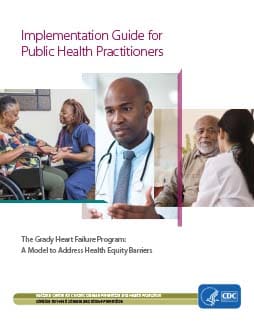Grady Implementation Guide
The Grady Heart Failure Program: A Model to Address Health Equity Barriers for Public Health Practitioners
What Is the Grady Implementation Guide?
Implementation Guide for Public Health Practitioners: The Grady Heart Failure Program: A Model to Address Health Equity Barriers (Grady Implementation Guide) provides public health practitioners and health care professionals with a detailed description of an effective intervention to address health disparities among heart failure patients.
The intervention was implemented at the Grady Heart Failure Program at Grady Memorial Hospital in Atlanta, Georgia. The Program was designed to address barriers to health equity at the individual level, especially among patients of low socioeconomic status.
This guide is based on the Program’s evaluation by CDC’s Division for Heart Disease and Stroke Prevention (DHDSP).
Who Should Use the Grady Implementation Guide?
This guide can benefit health care professionals, including cardiologists, nursing staff, and administrators of cardiac care clinics or departments.
Other public health professional concerned with continuity of care and addressing barriers to health equity for cardiovascular disease (CVD) patients may also find the guide useful.
Why Is Reducing Health Inequity Important?
Deep inequities affect access to health care and can lead to wide disparities in overall health status, especially for members of racial and ethnic minority groups. These circumstances can lead to disparities in chronic disease-related behaviors, health care access and use, and health-related quality of life.
For example, African Americans develop heart disease at younger ages, and deaths from heart disease are higher among African Americans than among their White counterparts.1 African Americans also have a higher incidence of congestive heart failure and greater mortality at earlier ages.2,3 Additionally, hypertension is both more prevalent and less likely to be controlled among African Americans.4
Hospitals play a vital role in creating a more equitable society through health care, wellness, educational, and service opportunities. The Grady Heart Failure Program is a hospital-based intervention that has the potential to build equity through activities that lead to greater patient health among disproportionately affected populations at higher risk for cardiovascular disease.
Spread the Word
- CDC’s Division for Heart Disease and Stroke Prevention has published a new implementation guide explaining how to use an intervention to help reduce readmission rates among cardiovascular disease patients. Learn how these tools can help address #HealthEquity and socioeconomic barriers for patients in your community. [Link to the Grady Implementation Guide landing page] #PublicHealth #CVD @GradyHealth [tag]
- The Grady Implementation Guide provides effective, evidence-based interventions for #PublicHealth practitioners to improve #HealthEquity in #CVD patients. Download the Guide from CDC’s Division for Heart Disease and Stroke Prevention. [Link to the Grady Implementation Guide landing page] @GradyHealth [tag]
- Support patients in your health system by using the Grady Implementation Guide, which provides evidence-based interventions to address socioeconomic barriers to #PatientCare at the individual level. Read more. [Link to the Grady Implementation Guide landing page] #HealthEquity #CVD @GradyHealth [tag]
- CDC’s Division for Heart Disease and Stroke Prevention has published a new implementation guide explaining how to use an intervention to help reduce readmission rates among cardiovascular disease patients. Learn how these tools can help address #HealthEquity and socioeconomic barriers for patients in your community. [Link to the Grady Implementation Guide landing page] #PublicHealth #CVD @Grady Health System [tag]
- The Grady Implementation Guide provides effective, evidence-based interventions for #PublicHealth practitioners to improve #HealthEquity in #CVD patients. Download the Guide from CDC’s Division for Heart Disease and Stroke Prevention. [Link to the Grady Implementation Guide landing page] @Grady Health System [tag]
- Support patients in your health system by using the Grady Implementation Guide, which provides evidence-based interventions to address socioeconomic barriers to #PatientCare at the individual level. Read more. [Link to the Grady Implementation Guide landing page] #HealthEquity #CVD @Grady Health System [tag]
- This @CDCHeart_Stroke publication features guidance on how to use interventions to reduce readmission rates among #CVD patients. Learn about tools to address #HealthEquity and socioeconomic barriers for patients in your community. [Link to the Grady Implementation Guide landing page] @GradyHealth
- The Grady Implementation Guide provides effective, evidence-based interventions for #PublicHealth practitioners to improve #HealthEquity in #CVD patients. Download the Guide from @CDCHeart_Stroke. [Link to the Grady Implementation Guide landing page] @GradyHealth
- Support patients in your #HealthSystem by using the Grady Implementation Guide, which provides evidence-based interventions to address socioeconomic barriers to care at the individual level. Read more from @CDCHeart_Stroke. [Link to the Grady Implementation Guide landing page] @GradyHealth
Newsletter
- The Grady Implementation Guide provides evidence-based interventions to address health disparities among patients with cardiovascular disease, specifically patients with heart failure. Using the Grady Heart Failure Program (GHFP) in Atlanta, Georgia as a model, this Guide provides considerations for replicating the implementation approach to address socioeconomic barriers to care at the individual level. The GHFP uses five core elements to promote adherence to an outpatient medical plan and achieve improved quality of care and patient health outcomes. This Guide can benefit a wide range of health care professionals, such as cardiologists, nursing staff, and administrators of cardiac care clinics. Download the Guide to learn more pdf icon[PDF – 3 MB].

